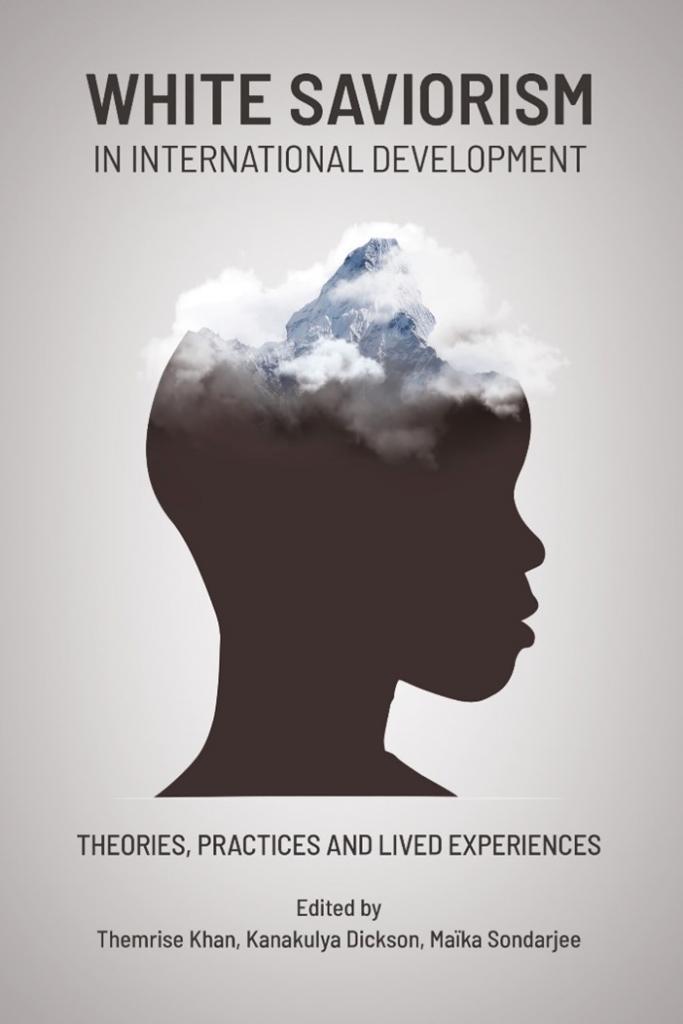Book Review - White Saviorism in International Development: Theories, Practices and Lived Experiences

White Saviorism in International Development: Theories, Practices and Lived Experiences edited by Themrise Khan, Kanakulya Dickson and Maika Sondarjee. Quebec: Daraja Press, 2023. 268 pp., $22 paperback 978-1-990263-18-7
Decolonial frameworks are gaining in popularity to analyse literature and critique hierarchical social systems. White Saviorism in International Development: Theories, Practices and Lived Experiences is a seventeen-chapter book divided into three categorical sections and edited by Themrise Khan, Kanakulya Dickson and Maika Sondarjee. It is a practical and actionable collation of reflections which engage critical, individual, and personalised lenses, thus providing lived, spoken, and applied knowledge to the reader. Despite the multiplicity of authors, their collective writings employ clear and simple English language which is intended as an act of deliberate disruption- to challenge gatekeeping of knowledge and provide reader accessibility to the Global South.
The prevailing theme of White Saviorism in Black and Brown lives is used to uncover conceptual underpinnings and morally questionable practices in the development and aid sector. The schism between “developed” and “underdeveloped” within global inequalities is highlighted in the Introduction to relay an understanding of the White Savior’s problematic “benevolence and altruism” (p. 3)- which only exists to save, develop, modernize, and civilize the “Global South”!
Divided into three parts, the first part, Theory and Practice, critically unpacks theoretical epistemologies and attitudes rooted in White Western norms and measures dictating the development and aid sector in Global South. The second part, Lived Experiences, is a contextual extension of the former part- it provides an insider perspective about differential treatment, internal politics, and non-whites replicating White Saviorism. Parts one and two are situated in a deep consciousness of local context, culture, and conditioning- and this awareness is paired with realisations and confessions of positionality. The third and last part, Conclusion, serves as a unifying compass tying in the theoretical, philosophical, and narrative commonalities in the book as a recognition of ongoing exploitation and the dire need for accountability.
 The authors reveal important and often shocking insight into racism, preferentialism, exploitation, and blatant violation of human rights. Chapter one details the “alien invasion” (p. 28) of colonizers, historical genocide, and the perpetual oppression following World War One - each one rooted in White Savior “ideologies and epistemologies” (p. 38). Marcelo Saavedra-Vargas advises: “Decolonize minds so young people can actually become good allies, and we take on the dismantling of the colonial realities together” (p. 40). Sadaf Shallwani and Shama Dossa discuss the role and prevalence of the White gaze and their problematic and quantifiable expertise during evaluation processes in the development sector (p. 48). The chapter advances the idea that White Saviorism is not only exercised through skin color, but is practised by Brown and Black people who benefit from Whiteness. Subsequently, Leila Benhadjoudja in chapter three uncovers the interference of White Saviors in Afghanistan and its use “as an emancipatory discourse for Muslim women” (p. 65). Furthermore, it highlights the villainization of Muslims, which redirects funds to security and the war on terror: thus highlighting the concerning Islamophobia and questionable use of White Saviorism to save Muslim women. This resonates with ideas that Muslim women carry their own cultural and historical significance (Mahmood, 2006) which is disregarded and turns them into neocolonial rescue projects for the West.
The authors reveal important and often shocking insight into racism, preferentialism, exploitation, and blatant violation of human rights. Chapter one details the “alien invasion” (p. 28) of colonizers, historical genocide, and the perpetual oppression following World War One - each one rooted in White Savior “ideologies and epistemologies” (p. 38). Marcelo Saavedra-Vargas advises: “Decolonize minds so young people can actually become good allies, and we take on the dismantling of the colonial realities together” (p. 40). Sadaf Shallwani and Shama Dossa discuss the role and prevalence of the White gaze and their problematic and quantifiable expertise during evaluation processes in the development sector (p. 48). The chapter advances the idea that White Saviorism is not only exercised through skin color, but is practised by Brown and Black people who benefit from Whiteness. Subsequently, Leila Benhadjoudja in chapter three uncovers the interference of White Saviors in Afghanistan and its use “as an emancipatory discourse for Muslim women” (p. 65). Furthermore, it highlights the villainization of Muslims, which redirects funds to security and the war on terror: thus highlighting the concerning Islamophobia and questionable use of White Saviorism to save Muslim women. This resonates with ideas that Muslim women carry their own cultural and historical significance (Mahmood, 2006) which is disregarded and turns them into neocolonial rescue projects for the West.
Themrise Khan in chapter four amplifies the reality that the White Savior is also the white woman who speaks “above women in the Global South and not just on their behalf” (p. 84). The White Matriarch (p. 82) in the development sector makes funding decisions and benefits from her whiteness in the Global South. The author encourages women of the Global South to challenge this dynamic and “push back against their White Northern counterparts” (p. 97). In chapter five, Kanakulya Dickson engages with the philosophical notion of “false consciousness” (p. 100) to illustrate a “moral void” where White Saviors (white and non-white in the Global South) function on the premise of non-accountability. Dickson asserts these points using reported examples- one of them being the sexual exploitation of girls and women in Haiti by Oxfam workers. Kizito Michael George in chapter seven delves into this moral deficit by discussing the White Savior’s attempt to employ their own epistemologies which they see as civilized and evolved, unlike “endogenous epistemologies” (p. 118). The ideal remedy to this is replacement, through Brown and Black endogenous pedagogies and practices. Chapter seven by Rose Esther Sincimat Fleurant and chapter eight by Robert Kakuru- both reflect on the role of White Savior institutions. They highlight the involvement and co-functioning of White Savior institutions in hijacking not only identity and education in Haiti (chapter seven), but also land grabbing in Uganda (chapter eight) which perpetuates powerlessness. The authors deconstruct a union of the White Savior mentality with powerful institutions which disempower, erase, and devalue those who are not privileged in the Global South.
Chapter nine by Fernando David Marquez Duarte, chapter ten by an anonymous author, chapter eleven by Amjad Mohamed Saleem, and chapter twelve by another anonymous author- all serve as lived experience narratives which complement the multitude of concepts discussed in Part One and expose different shades of White Saviorism.
Green efforts of Western NGOs, namely Sea Shepherd are criticized for holding a fallacious belief that their values supersede the “lives and wellbeing of people in the Global South” (chapter nine) (p. 167). This holds similarity to the questionable behaviour of tourists visiting sites of ethnotourism, where they undermine the intellect and integrity of those living within the local culture. White Savior gifts of thanks include giving “underwear…destined for the garbage” to medicine close to expiry, which verifies the distasteful extent to which White Saviors disregard and undermine people of the Global South (chapter ten) (p. 170). White Saviors also use their benevolent White gaze for projects in the Global South. They have ease and accessibility to 5-star hotels, SUV protocol, and their own insular friendships which allow for networking and opportunities, thus perpetuating neocolonial notions (chapter eleven). These divisive attitudes are also found within large institutions like the World Bank, where Brown people camouflage themselves into figures of authority to perpetuate the savior mentality to look down upon their own people (chapter twelve).
In chapter thirteen, Chongo Beverly Anne Mwila sheds light on the disturbing and invisible activity of child sponsorship for education where there is insufficient and unreliable monitoring- thereby implying that the children were in unfavourable conditions which the author thought of reporting, but was dismissed by others. This chapter highlights the mistreatment and exploitation of children within the development donor sector.
Jody Ann-Anderson emphasizes the dichotomy between salaries and treatment of “local staff and expats” which reinforces the power dynamic and assumption that the White gaze or White Saviors know better and should be paid better (p. 208). The author encourages readers to “interrogate” their status-quo and complicit behaviour (p. 210). This narration serves as a learning point on how to disempower and disengage with power hierarchies situated in the Global South but rooted within whiteness. In chapter fifteen, Radha Shah shares the complexity of gender in a Pakistani context and uncovers how professionals within the development sector recreate neocolonial behaviour within a situated context - thus providing a holistic frame that strays from portraying development efforts and engagements as purely noble causes. Chapter sixteen by Eddy Michel Yao shows that “voluntourism” is an extension of the White gaze where the Global South is used as a ground for observation to apply Western concepts and paradigms as a form of training for young people (p. 241). This shows that the Global South is treated as an experimental lab rat at the mercy of the powerful and privileged. The final chapter, seventeen, by Themrise Khan and Maika Sondarjee, reaffirms that the White Savior comes in many shapes and forms- as a man, as a woman, as an institution, as a benevolent act, and even as non-whites.
Distancing from White Western epistemologies is a recurring theme in each chapter- the book’s format, and choice of words are reflective of decolonial efforts. These efforts acknowledge the oppression of Black and Brown lives caused by the White Savior- while discussing the contribution of non-whites to the definition of White Savior. By engaging with personal histories, vernacular lenses, anonymity, story-telling formats, and local paradigms and perspectives- this book is a comprehensive guide to understanding what is wrong with the international development and aid sector. The authors avoid prescriptive or positivist measures to remedy this- instead they provide a practical and applicable approach which encourages self-reflection to detach from power structures that perpetuate White Saviorism.
Huda Syyed is a PhD candidate at Charles Darwin University, Australia. Her current topic of research focuses on the practice of ‘Female Genital Cutting’ and explores the lack of data, political activism and understanding regarding it in Pakistan. She also focuses on areas of gender, cultural context, politicised religion and societal concerns in South Asia. Recent article.
Note: This review reflects a personal effort to name each author to acknowledge their work and avoid misspelling or name erasure using short form or last names.
The review incorporates word spellings used in the book, for example Savior and not Saviour.
Reference
MAHMOOD, S. (2006). Feminist Theory, Agency, and the Liberatory Subject: Some Reflections on the Islamic Revival in Egypt. Temenos - Nordic Journal for Study of Religion, 42(1). https://doi.org/10.33356/temenos.4633


